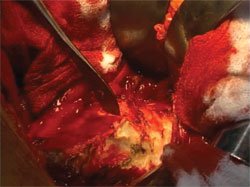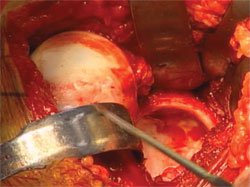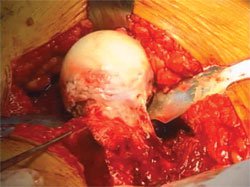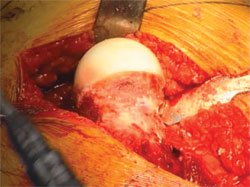Open dislocation, debridement helps handle intra-articular hip pathology
Questions remain regarding which labrums should be repaired and indications for patient age, weight.
Surgical dislocation and osteochondroplasty may help patients with femoral acetabular impingement stave off the development of hip osteoarthritis.
At the 37th Open Meeting of the Hip Society and the 15th Combined Open Meeting Hip Society and American Association of Hip and Knee Surgeons, Robert T. Trousdale, MD, discussed the operative technique and benefits of open dislocation and debridement and highlighted unanswered questions in impingement surgery.
The goal of treatment in young, active patients with viable articular cartilage is to restore the anatomy to as close to normal as possible, Trousdale said.
“At the present time, at our center, we still favor open procedure for the majority of these patients who have major structural problems about their hip joint,” he said. “The rational for the open dislocation/debridement procedure is that it has been shown to be safe. Professor Ganz has shown us that there is really no risk if the operation is done properly for avascular necrosis of the femoral head. Trochanteric problems [are] extremely rare and maybe most importantly, you can readily, efficiently handle all the intra-articular pathology that is present.”

Technique
The procedure allows surgeons to address rim lesions and labral pathology, he said. “It has been shown in some series that repair of the labrum may be a little bit more beneficial than debridement of the labrum in selective circumstances. With an open technique, you may be more readily able to repair the labrum and I do not think that we have a good handle on the optimal technique of labral repair presently.” In addition, surgeons using the technique can readily debride chondral flap tears and perform osteochondroplasty.
“We do a trochanteric osteotomy from posterior to anterior, leaving an anterior ridge of bone which provides stability at the time of refixation to prevent anterior/posterior displacement,” Trousdale said. During the procedure, he exposes the hip capsule by retracting the gluteus minimus and then performs a capsulotomy. He then dislocates the hip and places a retractor into the posterior aspect of the acetabular rim. He tracks the head posteriorly and gets full access to the acetabulum.
|
|
Images: Trousdale RT |
Research
In a recently published cadaver study, Trousdale and colleagues compared the accuracy of open and arthroscopic procedures. “In our hands, we were much more precise doing the osteochondroplasty/dislocation open versus arthroscopically,” he said. “Our location, depth and width were more precise with open procedure.”
Studies on open debridement show good outcomes with minimal complications, he said. “Suffice to say, we are now seeing short-term, intermediate follow-up series and all of these series show improvement in validated outcome scores for the majority, not all, but the majority of these patients,” Trousdale said.
|
|
|
However, there are few studies in the peer-reviewed literature reporting arthroscopic results. “There are lots of centers doing arthroscopic dislocation and are talking about it,” Trousdale said. “I do think that the future is less invasive techniques, but presently in my hands most of these lesions can be handled with an open procedure.”
He noted that many questions remain regarding impingement surgery including the indications for patient age. “Presently, patients over the age of 40 or 35 to 45, I am relatively hesitant to do a joint salvage operation on those patients, especially in light of the fact that we have got bearing surfaces that in our younger patients at least at their immediate follow-up seem to be relatively durable,” he said.
He added, “I do not think that we have got a handle on how severe the secondary arthritis should be and that may be in proportion to age. If someone is a teenager who has got structural problems with moderate hip changes, I’ll probably still do a joint salvage procedure on that patient. But, if the patient is 45 with moderate secondary degenerative changes, I will let nature take its course and proceed with an arthroplasty.”
For more information:Reference:
- Robert T. Trousdale, MD, can be reached at the Mayo Clinic, 200 First St. SW, Rochester, MN 55905; 507-284-2883; e-mail: trousdale.robert@mayo.edu. He has no direct financial interest in any products or companies mentioned in this article.
- Trousdale RT. Surgical dislocation and osteochondroplasty. Presented at the 15th Combined Open Meeting of the Hip Society and American Association of Hip and Knee Surgeons. Held at the American Academy of Orthopaedic Surgeons 76th Annual Meeting. Feb. 28, 2009. Las Vegas.




